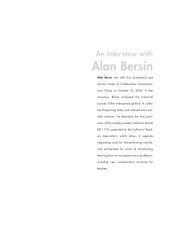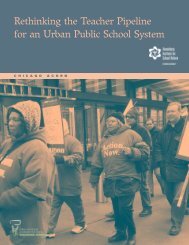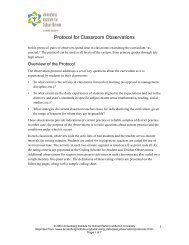Central Falls Transformation Report - Annenberg Institute for School ...
Central Falls Transformation Report - Annenberg Institute for School ...
Central Falls Transformation Report - Annenberg Institute for School ...
Create successful ePaper yourself
Turn your PDF publications into a flip-book with our unique Google optimized e-Paper software.
early challenges were also mentioned. One teacher specifically noted the team “has been<br />
terrific. . . . They’re struggling because of the newness of it [but] they’ll figure it out.” The<br />
challenges mentioned by others revolved around beginning to build a math curriculum<br />
with corresponding supports when last year the curriculum didn’t exist. Despite these challenges,<br />
teachers praised the strategy <strong>for</strong> the benefits it af<strong>for</strong>ded students.<br />
Sustaining Focus on English Language Arts<br />
Figure 15 shows the three-year pattern of English language arts (ELA) per<strong>for</strong>mance. In<br />
2009, 55 percent of CFHS students tested met proficiency, a 10 percent improvement<br />
from scores in 2008. Scores in 2010, however, decreased to 44 percent proficient.<br />
Staff Perceptions of Sustaining ELA Proficiency<br />
Staff also noted that students were not receiving enough reading supports, especially in<br />
comparison to the math supports received. Teachers specifically mentioned how reading<br />
interventions and programs were in place in the past few years, few of which were currently<br />
available. Some teachers also mentioned that English language learners were in need of the<br />
most reading support but that this support was not widely available.<br />
GENDER<br />
RACE/ETHNICITY<br />
STATUS<br />
CHARACTERISTIC<br />
FIGURE 15<br />
Grade 11 Student Proficiency on the Reading NECAP<br />
2008-2009<br />
% Proficient (N)<br />
YEAR<br />
2009-2010<br />
% Proficient (N)<br />
2010-2011<br />
% Proficient (N)<br />
All CFHS Students 45% (82) 55% (112) 44% (78)<br />
Female 50% (42) 60% (68) 48% (41)<br />
Male 40% (40) 50% (44) 39% (35)<br />
Black or African American 32% (9) 73% (19) –<br />
Hispanic or Latino 43% (58) 51% (77) 47% (59)<br />
White (non-Hispanic) 66% (15) 64% (16) 40% (17)<br />
Current LEP Student 4% (1) 3% (1) 11% (3)<br />
Economically Disadvantaged Students 42% (52) 54% (87) 45% (48)<br />
Students with an IEP 14% (5) 32% (15) 12% (5)<br />
RI State 69% (7,407) 73% (7,882) 76% (8,090)<br />
DATA SOURCE: The NECAP website, http://reporting.measuredprogress.org/NECAPpublicRI/select.aspx. This in<strong>for</strong>mation was extracted from each<br />
year’s respective <strong>School</strong>-Level <strong>Report</strong>, “Grade 11 <strong>School</strong> Results <strong>Report</strong> (Testing Year)”. Of note, percentages are the sum of Proficient (i.e., Level 3)<br />
and Proficient with Distinction (i.e., Level 4). A dash indicates blank; i.e., fewer than ten students were tested. Participation rates affect scores and<br />
the participation rate in 2010 was lower than the previous three years. The table displays the percent of students exhibiting each characteristic, with<br />
the actual number of students in parentheses.<br />
25













